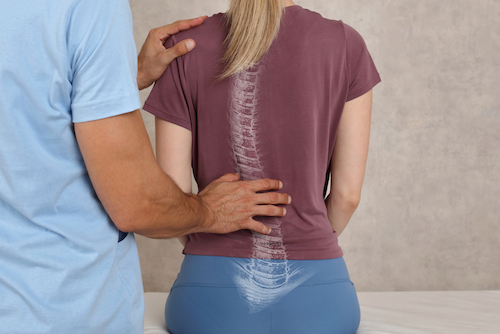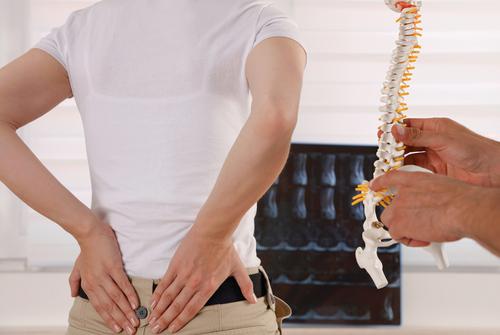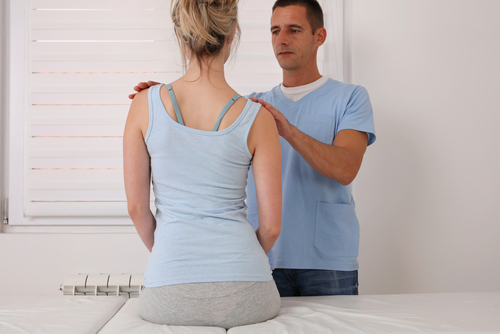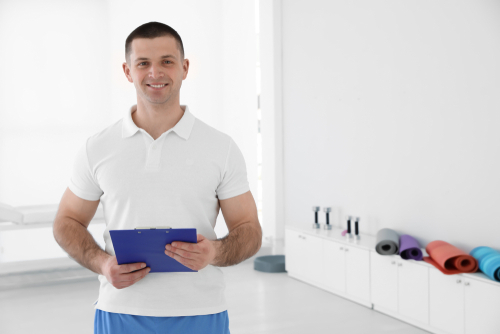
Scoliosis refers to a sideways curvature of the spine. It may cause a noticable “twist” in the back, an unevenness of the hips or shoulders, or it may be imperceptible.
The more severe scoliosis generally appears as a spinal deformity in childhood. Other, less severe forms of scoliosis can appear in later life.
Treatments include surgery, braces, and non-invasive manual therapy, depending on the type and severity of the condition.

Idiopathic scoliosis is when you have scoliosis from birth. This means it is first diagnosed in childhood and that the spine has developed with a sideways curvature without being caused by any external factors.
Degenerative scoliosis is a condition that may appear later in life due to the natural deterioration of the spinal discs and vertebrae with age. When this deterioration occurs more on one side of the spine than the other it can cause the spine to “lean” to one side, causing a scoliosis.
A functional scoliosis is caused by habits which over time cause the spine to lean to one side, often as the result of a separate condition. For example, someone with an ankle injury or sciatica might put more of their weight on the healthy leg in order to avoid pain, causing them to lean more to one side, over time resulting in a scoliosis. Since functional scoliosis is more likely to be caused by muscular adaptation than by skeletal factors or deterioration, it is more likely to respond well to treatment.

In very severe cases of idiopathic scoliosis, surgery may be recommended to attempt to return the spine to a more natural position.
When idiopathic scoliosis is in a child, a back brace may help their spine to grow into a more natural position. Like surgery, braces are prescribed by specialist doctors. A brace is a big decision and the social aspects of wearing a brace for the child must be considered alongside the potential for future improvement.
Because scoliosis is an exclusively musculoskeletal problem it cannot directly be treated with drugs. However, pain medication may help in situations where the condition causes pain.
In idiopathic or degenerative scoliosis physical therapy is used to help manage the condition by reducing the tension in muscles surrounding the spine and helping to reduce the pain caused in other parts of the body as a result of the scoliosis. Exercise including aquatherapy may also be beneficial.
In functional scoliosis physical therapy can often make a positive difference in helping to fix the condition. This may be by directly treating the scoliosis, e.g. by spinal manipulation or relaxation of the muscles holding the spine in the incorrect position, or by treating the underlying condition for which the body is compensating, allowing the body to retain its natural equilibrium.

At Beachside Osteopaths we provide specialist physical therapy for scoliosis at our Brighton clinic.
Osteopathy is a non-invasive physical therapy that can help manage more serious forms of scoliosis, and help to restore the natural curvature of the spine in milder cases of functional scoliosis. We are Allied Health Professionals and are registered with the GOsC and the iO. You can learn more on our about osteopathy page.
As well as providing specialist treatment to help with your scoliosis, we can also give you advice on living with your condition and expert advice on things like choosing the best mattress or chair, and on working or sleeping with scoliosis. We are also First Contact Practitioners, meaning we can assess you and refer you to the correct type of treatment if osteopathy is not suitable for your needs.
At your first appointment we will will carry out a comprehensive assessment of your condition. We will explain our diagnosis and treatment plan and how many sessions we think you will need before proceeding to treatment. We pride ourselves in treating the person behind the problem, and aim to make sure you feel involved and listened-to at every stage of the treatment process.
Finding an available appointment and booking online is quick and easy using the link below. You might also be interested in our about us and what to expect pages. Of course if you have any questions please don’t hestitate to contact us.
Finding an available appointment and booking online is quick and easy

Scoliosis Association UK provides support and information to people living with scoliosis
The Scoliosis Research Society provide advice and the latest scoliosis information
Teens Health provides useful information on scoliosis in children
You can also find further information on scoliosis from Spine Health, OrthInfo, WebMD and the NHS.
The information on this page was last reviewed on 1 June 2022 by Barney Smith MSc, Clinical Director, Beachside Osteopaths
Book a call and start growing your practice
Market Your Clinic Online
34 Windmill House
Waterloo
London SE1 8LX
Market Your Clinic Online is a trading name of Red Balloon Web Limited